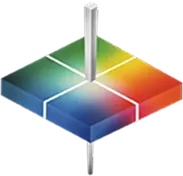
What if your next plant-based drink could achieve stunning golden color—naturally, consistently, and without compromising shelf life? That vision just moved closer to reality.
A peer-reviewed study in Food Frontiers reveals how a one-step pH infusion of raw turmeric into soymilk delivered reliable, vibrant color. Using the HunterLab ColorFlex EZ spectrophotometer, researchers tracked L*, a*, b* values to evaluate and confirm the consistency of this natural process.
Please note: the ColorFlex EZ has now been upgraded to the ColorFlex L2. For a seamless transition and added benefits, you’ll find more details in the second half of this blog.
Key Findings from the Study
This study offers compelling evidence for a practical, clean-label solution:
- 94% curcumin transfer from raw turmeric into soymilk, with stable particle size and charge
- Both curcumin–soymilk and turmeric–soymilk showed b* increases above 40 units versus plain soymilk, creating a distinct golden-yellow hue
- Both freeze-dried curcumin–soymilk and turmeric–soymilk powders remained stable over a 30-day storage period at freezing temperature.
These results highlight how tristimulus color measurement enables effective monitoring of natural pigment integration across product lifecycles. More importantly, they demonstrate a path to achieving natural color in plant-based milk—a key priority for brands focused on clean-label innovation.
Why It Matters to HunterLab Customers
For Plant-Based Beverage Producers
The study provides a scalable route to functional pigment delivery. Use ColorFlex L2 to maintain color consistency across shelf life with simple benchtop quality control.
For Turmeric and Spice Processors
Validate raw turmeric batches without requiring purified extracts. ColorFlex L2 readings enable quick grading and premium positioning for buyers.
For Nutraceutical Brands
Support label claims of protein and curcumin co-delivery. Tristimulus color data confirm dose uniformity in ready-to-mix formulations.
For Food Science R&D Teams
Leverage a peer-reviewed protocol pairing pH encapsulation with tristimulus tracking. Reproduce or expand for other botanicals.
For Quality Labs and Co-Packers
Color shift is a primary indicator of curcumin degradation. Use ColorFlex L2 for quick pass/fail metrics before packaging.



